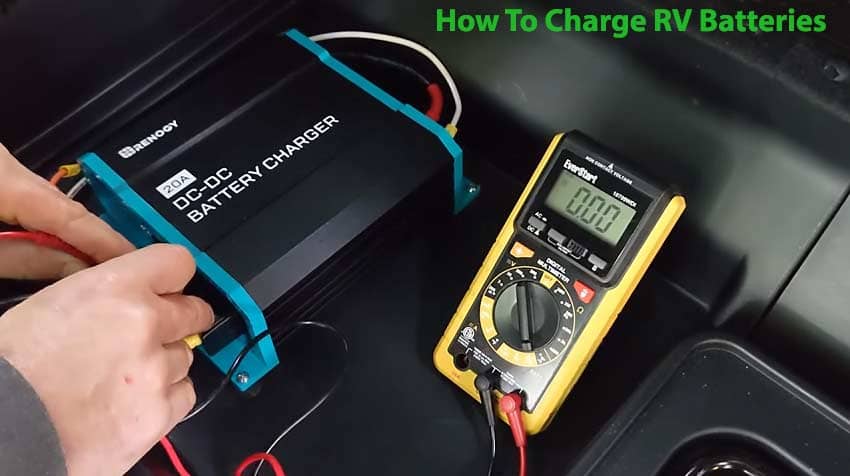
Paying attention to the RV batteries is important because the function of every RV appliance depends on the battery. You are here to learn about the charging methods of RV batteries, and we will guide you in deciding on the best method. Two kinds of batteries are known for a properly functioning RV power source.
The chassis (starter) battery is like a car battery, making a motorhome run. The deep cycle (house) batteries run all the RV lights and appliances when the shore power is unused. During dry camping or zero shore power, house batteries are extremely important. However, an RV battery is just like other batteries in case of losing power and needing a recharge. And because of this fact, RV battery chargers are one of the most important accessories for your batteries.
Four Ways RV Deep Cycle Battery Can Be Charged:
- An alternator charges the RV battery while driving.
- A converter will trickle charge the RV battery when connected to shore power.
- When running a generator, RV’s deep cycle battery also charges.
- Final option allows charging through solar power usage.
If you are out in your RV regularly, charging the battery may become necessary for a few times. If you learn the methods to charge your RV battery, enjoying all the perks your recreational vehicle has to offer will become easier.
RV Battery Charging
The RV batteries charge when it is connected to an electric outlet. An RV Converter can convert the grid power into 12-volt DC for channeling it to the RV adapter. When the generator is functioning or the motor of the RV is functioning, batteries can also charge. You can check it in an attached RV battery monitor.
Keeping the RV always plugged in may result in draining the water level of the wet-cell batteries. For this reason, you have to ensure checking the water level often if you camp. It is also important to know that letting the charge of the batteries get too low harms their overall lifespan. So, always try to track the charge level and charge it regularly. It does not matter what method you opt for charging the batteries as they require voltage only.
So, it can charge from an alternator, or a generator, or a simple battery charger, or in a greenway with solar and wind, or it can be plugged into shore power through the built-in converter.
What matters is the amps the batteries receive for that charge. For example, a pair of Trojan T105’s charges at 22.5 amps. Note that, batteries genuinely have a 10% rule. Meaning, being charged at 10% of the amp-hour rating of the batteries. So, if the pair is rated at 225 amp-hours, they would require 22.5 amps of charge. Now, if one deep cycle 12-volt battery has about 80 amp-hours, they will require 8 amps of charge.
Charging Methods of Your RV Batteries
First off, batteries are not fond of sitting around and they self-discharge whether hooked up or not every month.
1. Converter-chargers
One of the most basic systems (rated in amps) for converting 12-volts of shore power into DC 12-volts. The built-in converter/charger in the RV is generally a 30-40 amp 3/5 stage charger. If you are new into the motorhome thing, make sure to check the converter/charger is properly working.
2. Battery Chargers or Direct DC power
There are some ways through which charging your battery is possible without having to start with the converter first. A 3 or 5 stage battery charger can provide you about 30 amps. About 55 DC amps can power up your whole RV including the lighting and appliances. Instead of simultaneously running AC appliances these charging methods will charge your battery. Then the battery will send power through the inverter for powering the AC appliances.
3. Generators
A generator usually is not a great charger, can produce enough energy to power an entire RV. They usually put in 120-volts of power and help the RV’s converter/inverter charger recharge the battery. Some portable generators can power a battery through the output terminal of DC but just not enough to completely charge it. Just switch the generator off afterward when done. Be careful of the voltage fluctuations occurring on campgrounds. Mainly wiring problems cause them to result in severe damage to your RV.
4. Alternator
They can provide their (5-10) % of amp ratings only to the batteries. The rest of the amp rating is taken up by the heater, lights, wiper, etc. A typical 80 amp alternator after charging the starting battery can provide 4-8 amps to the camping battery.
5. Solar
Under the bright sun, a charge controller will give you 5 amps from a 100-watt solar panel to the batteries. Solar power chargers take careful planning and can be wired to the battery directly. A lot of research conduction is needed along with a professional for installing the solar panels as a charger.
Enjoy camping, and ensure you get the most life out of your RV batteries. But first, ensure you are discharging them 50%, and then with the 10% rule charging them back up fully. Knowing how to charge your motorhome batteries certainly will allow you to enjoy RVing benefits. So, when you are not camping, allow them on a smaller amp trickle charger into storage.
We hope it’s now clear How to charge an RV Battery.